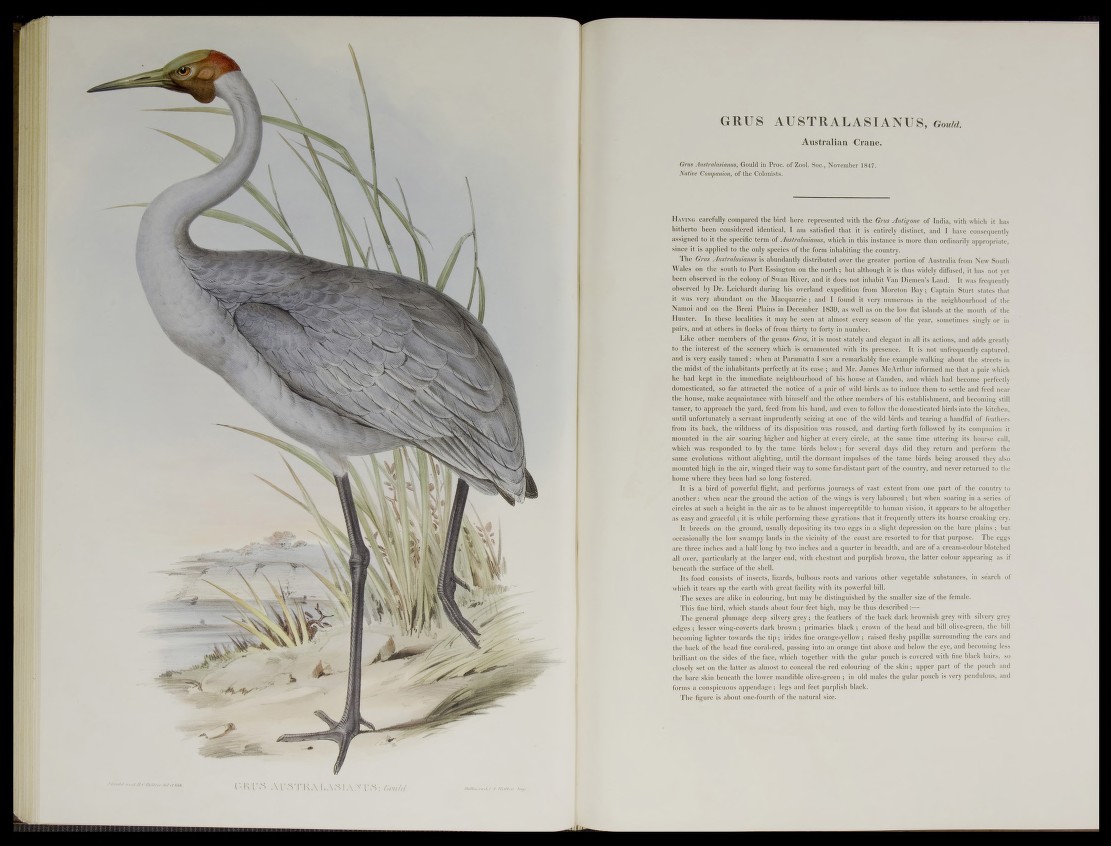
Bâtît!
5 * -
G | ® AUS TRALA S IANUS , Gould.
Australian Crane.
Crits Australasianus, Proc, of ZoolsySop., November 1847.
Native Companion, of
H aving carefully compared the bird here represented Antigone of India, with which it has
^ ^ ^ ff ib e en considered identical, I am’ that it is entirely distinct, and I have consequently
assigned to it the spécifie term of Australasianus, which in this instance is more than ordinarily appropriate,
«sincjppËs applied to the only .species pf the form inhabiting the country.
The Grus Australasianus is abundantly distributed over the greater portion of Australia from New South
Wales on the south to Po rt Essington on the north ; but although it is thus widely diffused, it has not yet
been observed in the^co^qn^f Swan River, and i t doe's not inhabit Van Diemen’s Land. It was frequently
o^êrÿed Leichardfcffi^B his overland e ig ^ ^ S f r om Moreton Bay ; Captain Sturt states that
it .iyasv very abundant op the Macquarrie ; and very numerous in the neighbourhood of the
||fe thé Brezi on the low ia ||||||^ J at the mouth of the
Hunter. In these dgcal§|ps^hi' njâ^Éie.en at almost evérypeason. of the year, sometimes singly or in
pairs^ndï’a^thers in flocks of from thirty to forty in number.
r Like' other-members o f the genus, Gtys,, itWsImost stately and elegant in all its actions, and adds greatly
to the interest o f the scenery which is'; ornamented "with its presence. It is not unfrequently captured,
and tamed : when at Paramatta I saw apemarkably fine example walking fÿ o u t the streets in
tÿ é midst o f t l^ ^ ^ ^ g h ^ | e r fe c t ly at its ease ; 'ahi^^ ^ pames McArthur informed me tha£a pair which
he had k ep t i j t h ^ ^ n l f ^ t e .neighbourhood of his housejÿ^^^S^ ^ Snd which had become perfectly
domesticated, so far^attracted the2hpti<$Tpf a pair of wild bijedf % ^ o |^ u c e them to settle and feed near
the house, make' acquaihtance-with himself and the other members o f ,h establishment, and becoming still
tamer, to approach the yarjp,. feed^from;his hand, and even to follow the domesticated birds into the kitchen,
until unfortunately a servant imp^^h#y^^izin^at one p f the wild birds and tearing a handful of feathers
from its back, the wildness of its disposition was roused, and darting forth followed by its companion it
mounted in. the air soaring higher and higher at every circlef/at-the same time uttering its hoarse call,
which was responded to by the tame birds below; for several days did they return and. perforin the
same evolutions without alighting, until the dormant impulses o f the tame birds being aroused they also
mounted high in the air, winged their way to some far-distant part o f the country, and never returned to the
diome where they been had so long fostered.
It is a bird o f powerful flight, and performs journeys o f vast extent from one part o f the country to
another : when near the ground the a®tóou^ó#<the wings is but when soaring in a series of
circles at such a height in the air as to heMlj^W^pefcepfiBle■ fdtSuri^ ^ plsion, it appears to be altogether
as easy and graceful ; it j^ pm lé -perfPIrming,- these gyr^ion^ tKa^it frequently utters its hoarse croaking cry.
It breeds on the g ro u ^ ^ ^ m lv depositing itsitftfp e g g s fe ^ slight depression oil the bare plains; but
occasionally the low swampy lands in the vicinity of the coast are-resorted to for that purpose. The eggs
are three inches and a h a lf lo n ÿ h | two inches and a quarter in breadth, and are o f a cream-colour blotched
all over«, particularly at the larger end', with chestnut and p|roji^^g)wn^ the lattercojonr appearing as if
beneath the surface o f the shell.
Its food consists o f insects, lizards, bulbous roots and various, other vegetable substances, in search of
Whihbdt tears up. the earth with great facility with, its powerful.
The sexes are alike in colouring, but may be distmguished by the smaller size o f the female.
This fine bird, which stands about fo% x% e^ to b p n ^ ^ ^ thus d e s c r^ d ,^ ^ ^ g
The general plumage deep;,si^ér3t^ÉE^ \ the feathers of- the back darkjbxQwnish grey with silvery grey
edges ; lesser wing-coverts dark brown ; primaries black ; iS S p ^pfejthe head and bill olive-green, the bill
béçôming lighter toward s ith e^^giri^s fine orangeTyêllow fàiseÿlfeshy papillæ surrounding the ears and
the back of the head fine coral-red, passing into ah or^hge/iint above an d below the eye, and becoming less
brilliant on the sides o f the face, which together with the gular pouch is covered with fine black hairs, so
closely set on the latter as almost to conceal the red colouring o f the/skim; upper part of the pouch and
the bare skin beneath the lower mandible olive-green ; 'in old males the gular pouch is very pendulous, and
forms a conspicuous appendage ; legs and feet purplisb black.
The figure is about onerfpnrth of the natural size.